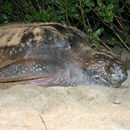en
names in breadcrumbs


Feeds largely on jellyfish and is capable of making dives as deep as 1,000 m below sea surface.
Critically Endangered
A distinctive, unique species; the largest of all marine turtles, reaching 1,800 mm in carapace length, 2,770 mm between forelimb tips. Carapace and plastron leathery, without horny plates;carapace depressed, elongate, with 7 longitudinal ridges, posterior edge smooth, ending with a narrow, pointed extensioover the tail. Plastron with 5 longitudinal ridges. Head relatively small; upper jaw with two tooth-like projections. Front limbs very long, with no claws. Not much difference in size between sexes, but males have longer tails. Color of carapace and dorsal sides of limbs and head blackish or bluish black with irregular whitish spots. Ventral sides pinkish white with some dark spots.
Essentially a vagrant to Egyptian waters, not known to breed in or near Egypt. It has been recorded several times from Egyptian territory in both the Mediterranean and Red Sea. From the Mediterranean Flower (1933) reports a large individual from the Alexandria market, but was not sure of its capture locality. Baha El Din (1992) reports 3 dead animals found on the shore at Zaranik and El Arish. Clarke et al. (2000) reports a further dead individual found on the beach at Rafah in 1998. In the Red Sea Werner (1973) reports the species from Nuweiba and south of Abu Rudeis. Frazier and Salas (1984) report 2 old specimens found in the vicinity of Hurghada, which were in the Hurghada Marine Biological Station in the early 1980s.
Circum-global, more readily entering colder waters than any other marine turtle. Although this species largely nests within the trop¬ics, it ranges widely into subtropical and temperate waters, even reaching the Arctic Circle.
Highly pelagic, spending much of its life far offshore, but often also close to shore.